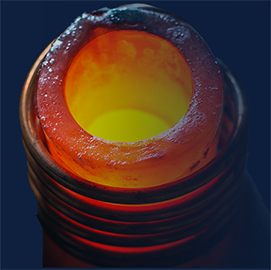Induction Brazing an Aluminum Assembly
Objective A company wanted to assess using induction heating for their aluminum assembly brazing process, and contacted THE LAB at Ambrell to utilize...
Applications
Applications: More
Applications: More

Industries:
Industries: More
Industries: More
Industries: More

Products:
Products: More
Services:
Services: More

Learn:
Learn: More
About:


THE LAB at Ambrell tested an application that involved heating a graphite crucible to 1,292 ºF (700 ºC) to melt aluminum to liquid form for a casting application. THE LAB determined that an Ambrell EKOHEAT® 50 kW induction heating system with a ten-turn helical coil would be the optimal solution for this casting application.
As mentioned, a ten-turn helical coil was used to heat the graphite crucible. The application was successful as it melted the aluminum to liquid form within 25 minutes, meeting the client's objective. Once the aluminum was melted it was then cast. No stirring was involved, molten sunk to bottom of crucible and aided in the melting process.
Melting with induction heating from Ambrell offers several benefits. Hands free heating is possible, which leads to repeatability and doesn't require operator skill. Induction is also rapid and a comparatively clean heating method. It is more efficient and cost effective than a gas furnace and does not heat up the manufacturing area. Finally, there's an even distribution of heat that lends itself to consistency.
If you have an application that could benefit from induction heating, you should consider free induction heating applications testing, including our Remote Lab Service. With Remote Lab Service, you can view testing live in our laboratory from the comfort and convenience of your office.

Objective A company wanted to assess using induction heating for their aluminum assembly brazing process, and contacted THE LAB at Ambrell to utilize...

Induction heating is a process that uses electromagnetic fields to heat electrically conductive materials. It has been used in numerous industries...

Induction heating, a process that uses electromagnetic induction to heat electrically conductive materials, is often thought of for large industrial...